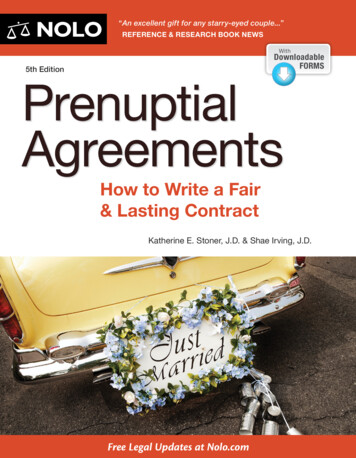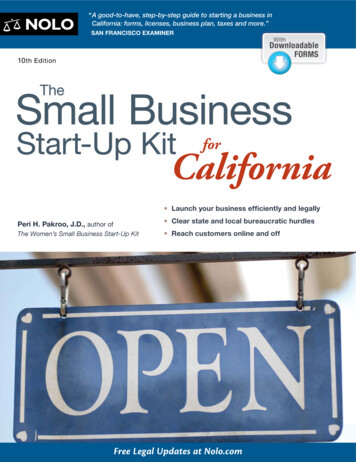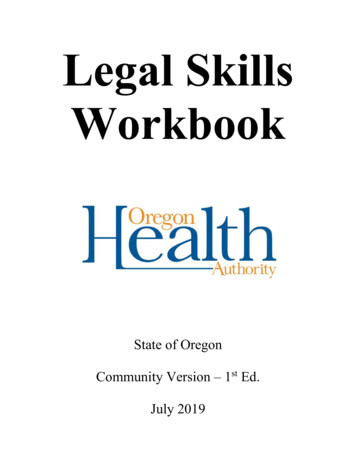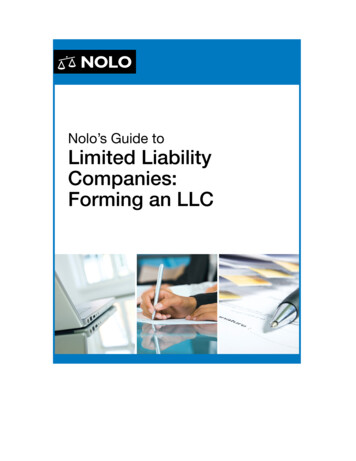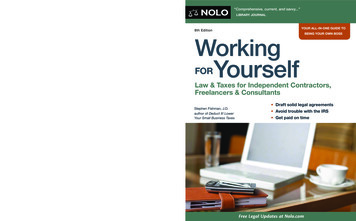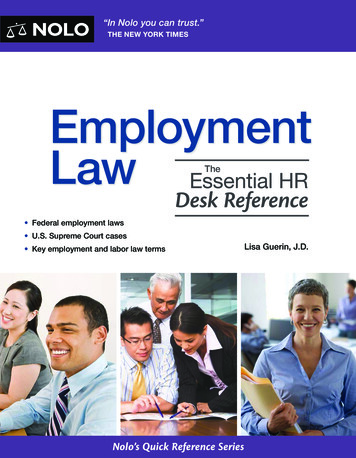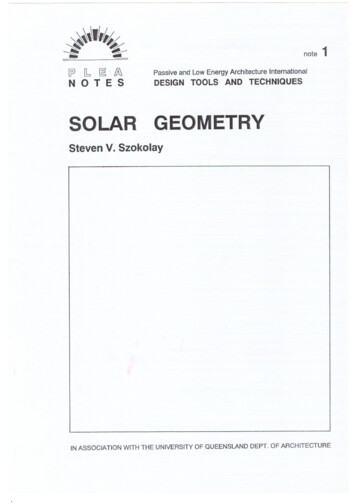
Transcription
Maryland Law ReviewVolume 25 Issue 3Article 4The Plea of Nolo ContendereThomas C. Hayden Jr.Follow this and additional works at: http://digitalcommons.law.umaryland.edu/mlrPart of the Criminal Procedure CommonsRecommended CitationThomas C. Hayden Jr., The Plea of Nolo Contendere, 25 Md. L. Rev. 227 (1965)Available at: iss3/4This Casenotes and Comments is brought to you for free and open access by the Academic Journals at DigitalCommons@UM Carey Law. It has beenaccepted for inclusion in Maryland Law Review by an authorized administrator of DigitalCommons@UM Carey Law. For more information, pleasecontact smccarty@law.umaryland.edu.
Comments and CasenotesTHE PLEA OF NOLO CONTENDEREBy THOMAS C. HAYDEN, JR.The twentieth century has seen the revival of the use of the pleaof nolo contendere in criminal proceedings' after the plea had fallen intodisuse and was apparently headed for oblivion. Generally speaking,the plea of nolo contendere is an implied confession which admits thefacts charged in the indictment and thus is similar to a guilty plea.However, the nolo plea admits the facts for the sole purpose of thecriminal prosecution. Therefore, unlike a guilty plea, it cannot be usedas an admission in a subsequent civil suit.The plea had it origin in the English common law, and the classicstatement indicating its characteristics is found in Hawkins:"An implied confession is when a defendant, in a case notcapital, doth not directly own himself guilty, but in a manner admitsit by yielding to the King's mercy, and desiring to submit to a smallfine: in which case, if the court think fit to accept of such submission, and make an entry that defendant prosuit se in gratiamregis, without putting him to a direct confession, or plea (whichin such cases seems to be left to discretion), the defendant shallnot be estopped to plead not guilty to an action for the same fact,as he shall if the entry is quod cognovit indictamentum."'Thus, it seems that in England the plea was originally in the nature ofa petition for mercy, and the courts still have a tendency to reducepunishment when a nolo plea is entered.'There is no reported use of the plea in England since 1702,' andthe plea has apparently been discarded there. However, the noloplea has found refuge in America. The use of the plea in thiscountry has not brought about any radical departure from the Hawkinsdefinition, although some problems have arisen concerning the useand effect of the plea. The renaissance of the plea is particularly1. For a general discussion of the plea, see Annot., 89 A.L.R.2d 540 (1963),supplementing 152 A.L.R. 253 (1944); 14 Am. Jur. Criminal Law § 275 (1938)and 22 C.J.S. Criminal Law § 425 (1961).2. HAWKINS, A TREATISE OF THEPLEAS OF THE CROWN 466(8th ed. 1824)cited in Hudson v. United States, 272 U.S. 451 (1926).3. See, e.g., Hudson v. United States, 272 U.S. 451 (1926), where the Courtstates at p. 457: "Undoubtedly a court may, in its discretion, mitigate the punishmenton a plea of nolo contendere and feel constrained to do so whenever the plea is acceptedwith the understanding that only a fine is to be imposed. But such a restriction mademandatory upon the court by positive rule of law would only hamper its discretionand curtail the utility of the plea."4. Regina v. Templeman, 1 Salk 55 (Q.B. 1702), appears to be the last reporteduse of the plea.
MARYLAND LAW REVIEW[VOL. XXVevident in criminal anti-trust prosecutions where a growing numberof defendants have used the plea in recent years.'By making a plea of nolo contendere the defendant has an opportunity to mitigate his punishment and avoid the stigma of a guiltyplea. Additionally, he avoids the time and expense involved in defending a criminal prosecution. Equally important to the defendantis the knowledge that the plea does not estop him to deny the factsin a subsequent civil suit arising out of the same facts.I. APPLICABILITYThe plea of nolo contendere is recognized in the federal courtsand in the majority of the states. 7 However, it has been held in somestates that if the plea is not provided by statute, it is not available toa defendant.8Although courts have accepted a nolo plea in cases involvingabortion,9 arson, x assault," espionage, 12 larceny, 3 and rape,' 4 the determination of the applicability of the nolo plea to a particularcrime is a difficult problem. It can be stated generally that the pleais more likely to be accepted to a misdemeanor charge than to acharge of a felony." Also, both federal and state courts are in clearagreement that the plea cannot be made to an indictment for acapital offense unless specifically allowed by statute.'" This limitation5. See Lenvin and Meyers, Nolo Contendere: Its Nature and Implications, 51YALe L.J. 1255 (1941-42).6. Rule 11 of the Federal Rules of Criminal Procedure states: "A defendantmay plead not guilty, guilty, or, with the consent of the court, nolo contendere."7. Young v. People, 53 Colo. 251, 125 P. 117 (1912) ; Krowka v. Colt Patent FireArm Mfg. Co., 125 Conn. 705, 8 A.2d 5 (1939); State v. Febre, 156 Fla. 149, 23So. 2d 270 (1945) ; Nelson v. State, 87 Ga. App. 39, 75 S.E.2d 39 (1953) ; LouisianaState Bar Assoc. v. Connolly, 206 La. 883, 20 So. 2d 168 (1944); Cohen v. State,235 Md. 62, 200 A.2d 368 (1964) ; State v. Perkins, 129 Me. 477, 149 At. 148 (1930) ;Chester v. State, 107 Miss. 459, 65 So. 510 (1914) ; Nebraska State Bar Assoc. v.Stanosheck, 167 Nebr. 192, 92 N.W.2d 194 (1958) ; In re Berardi, 23 N.J. 485, 129A.2d 705 (1957); State v. Barley, 240 N.C. 253, 81 S.E.2d 772 (1954); Commonwealth v. Shrope, 264 Pa. 246, 107 At. 729 (1919) ; State v. McElroy, 71 R.I. 379,46 A.2d 397 (1946); Roach v. Commonwealth, 157 Va. 954, 162 S.E. 50 (1932);State v. Page, 112 Vt. 326, 24 A.2d 346 (1942) ; State ex rel. Clark v. Adams, 144W.Va. 771, 111 S.E.2d 336 (1959); Brozosky v. State, 197 Wis. 446, 222 N.W. 311(1928) ; McNab v. State, 42 Wyo. 396, 295 P. 278 (1931).8. May v. Lingo, . Ala . , 167 So. 2d 267 (1964) ; In re Eaton, 14 Ill.2d338, 152 N.E.2d 850 (1958) ; Mahoney v. State, 196 Ind. 335, 149 N.E. 444 (1925) ;Federal Deposit Ins. Corp. v. Cloonan, 165 Kan. 68, 193 P.2d 656 (1948) ; State v.Kiewel, 166 Minn. 302, 207 N.W. 646 (1926) ; People v. Daiboch, 265 N.Y. 125, 191N.E. 859 (1934) ; and Laughlin v. Lamar, 205 Okla. 372, 237 P.2d 1015 (1951).9. State ex rel. Gehrmann v. Osborne, 79 N.J. Eq. 430, 82 Atd. 424 (1912).10. Teslovich v. Fireman's Fund Insurance Co., 110 Pa. Super. 245, 168 Atl.354 (1933).11. Orabona v. Linscott, 49 R.I. 443, 144 Atl. 52 (1928).12. Farnsworth v. Sanford, 33 F. Supp. 400 (D. Ga., 1940).13. Collins v. Benson, 81 N.H. 10, 120 Atl. 724 (1923).14. Johnson v. Johnson, 78 N.J. Eq. 507, 80 Atl. 119 (1911).15. 14 Am. Jur. Criminal Law § 276 (1938).16. Hudson v. United States, 272 U.S. 451 (1926); Commonwealth v. Shrope,264 Pa. 246, 107 Atl. 729 (1919) ; and Roach v. Commonwealth, 157 Va. 954, 162 S.E.50 (1932). But see State v. Martin, 92 N.J.L. 436, 106 Atl. 385 (1919). Section 2A:113-3 of N.J. STAT. ANN. provides that "Nothing herein contained shall prevent theaccused from pleading non vult or nolo contendere to the indictment [for murder];the sentence to be imposed, if such plea be accepted, shall be either imprisonment forlife or the same as that imposed upon a conviction of murder in the second degree."
1965]PLEA OF NOLO CONTENDEREseems to follow as a matter of course from Hawkins' definition of theplea's applicability to "cases not capital". The theory of the limitationis that capital cases are so serious that an implied confession shouldnot be allowed to "rise to the degree of certainty which would makeit the equivalent of an express confession. "17It is now settled that the nolo plea can be accepted by the federalcourts in felony indictments. This question was presented for the firsttime in Tucker v. United States," which held, "[T]he rule affordsno grounds for entertaining the plea, either in cases of felony, requiringinfamous punishment to be imposed on conviction, or in cases of misdemeanor for which the punishment must be imprisonment for anyterm, with or without fine."' 9 This position was changed by theSupreme Court in Hudson v. United Sates,2" where the defendants wereallowed to plead nolo contendere to a charge of using the mails todefraud, a felony punishable by fine or imprisonment, or both, andwere sentenced to imprisonment for a year and a day. The SupremeCourt held that the statement in Hawkins' definition - "desiring tosubmit to a small fine" - was illustrative only and not a conditionbinding on the court.The state courts are in disagreement as to whether the plea canbe accepted on felony indictments. Of those states which recognizethe plea, it is settled in four that the plea can be made on a felonyindictment.2' Two other states 22 have limited the applicability of theplea to misdemeanors. The limitation of the plea to cases of misdemeanors appears more in keeping with Hawkins' definition, whichstates that the defendant is willing "to submit to a small fine". Thecommentators seem to agree with this position.2II. ACCEPTABILITYIn jurisdictions where the plea is recognized, courts are in agreement that the plea cannot be entered by the defendant as a matterof right, and that acceptance of the plea is discretionary with thecourt,2524 as is the withdrawal of a nolo plea and substitution of anotherplea.17. Commonwealth v. Shrope, 264 Pa. 246, 250, 107 Atl. 729, 730 (1919).18. 196 F. 260 (7th Cir. 1912).19. Id. at 267.20. 272 U.S. 451 (1926).21. Commonwealth v. Ingersoll, 145 Mass. 381, 14 N.E. 449 (1888); State v.Martin, 92 N.J.L. 436, 106 Atl. 385 (1919) ; Commonwealth v. Shrope, 264 Pa. 246,107 At. 729 (1919) ; and In re Lanni, 47 R.I. 158, 131 Atl. 52 (1925).22. Williams v. State, 130 Miss. 827, 94 So. 882 (1922) ; and Roach v. Commonwealth, 157 Va. 954, 162 S.E. 50 (1932). In the latter case, the court stated, "[U]nderthe prevailing law in this state a plea of nolo contendere cannot be accepted in afelony case." 162 S.E. at 52.23. See, e.g., ANDERSON, WHARTON'S CRIMINAL LAW AND PROCEDURE § 1903(1903) ; and BISHOP, NEW CRIMINAL PROCEDURE § 802.2 (4th ed., 1895).24. Hudson v. United States, 272 U.S. 451 (1926) ; Mason v. United States, 250F.2d 704 (10th Cir. 1957) ; United States v. Lair, 195 F. 47 (8th Cir. 1912) ; TwinPorts Oil Co. v. Pure Oil Co., 26 F. Supp. 366 (D. Minn. 1939); Cohen v. State,235 Md. 62, 200 A.2d 368 (1964) ; Commonwealth v. Horton, 26 Mass. 206 (1829)and Williams v. State, 130 Miss. 827, 94 So. 882 (1922).25. Withdrawal of the plea has been allowed in Lott v. United States, 367 U.S.421 (1961) and Sullivan v. United States, 348 U.S. 170 (1954). Contra, United
MARYLAND LAW REVIEW[VOL. XXVSince the acceptance of the plea is discretionary with the court,there is only a small number of cases in which the acceptability of theplea has been litigated. In United States v. Jones,2" defendants wantedto plead nolo contendere to avoid providing evidence which could beused against them in potential civil litigation. The court adopted aliberal approach in accepting the plea, stating, ". . . in the absence ofsome reason why a defendant should not have the benefit of the plea,the Court will ordinarily allow it to be entered.""1Later cases have not adhered to the liberal approach of Jones.The case of United States v. Bagliore2 s stated that, "although the generalpolicy of this Court is hostile to the acceptance of such a plea (nolocontendere), circumstances surrounding the event and the condition ofthe defendant frequently make a strong appeal to the exercise of theCourt's discretion." 2 9 The Bagliore court accepted the plea, saying that,"in the trial of a criminal action, mental disorder and abnormalityexisting at the time of the act charged appears to be a just andequitable reason for accepting a plea of nolo contendere."'3In United States v. Chin Doong Art,3 the defendant and otherswere charged with conspiracy to violate the criminal laws of theUnited States with respect to entry, residence, and citizenship. A firsttrial ended in a deadlocked jury, and the defendant applied for permission to enter a nolo plea. In support of his application the defendantargued that a second trial would involve many additional witnesses,that he would be spared harsh and unnecessary results by a plea ofnolo, and that he had been a prominent citizen.In denying the nolo plea, the court concluded that "the primarypurpose of accepting a plea of nolo is to promote the administration ofjustice. This means justice not only for the defendant but also for thepublic. The Court cannot permit its action with respect to a pleaof this type breed contempt for law enforcement. '3 2 The court indicated that it would not accept a nolo plea "unless the situation isan extraordinary one, ' 33 and that the presence of moral turpitude in acase is a factor in determining the acceptability of the plea.3 4 Sincethe government had to prove its case beyond a reasonable doubt, thecourt concluded that although the case would be difficult and protracted, this factor alone did not per se present an exceptional circumStates v. Central Supply Ass'n, 74 F. Supp. 388 (N.D. Ohio 1947). Rule 32(d) ofthe Federal Rules of Criminal Procedure provides that motions to withdraw a pleaof nolo contendere may be made before sentence is imposed.26. 119 F. Supp. 288 (S.D. Cal. 1954).27. Id. at 290.28. 182 F. Supp. 714 (E.D.N.Y. 1960).29. Id. at 716.30. Ibid. The court also pointed out that "A plea of nolo contendere has advantages to a criminal defendant and, like a plea of guilty, it is also beneficial to theGovernment in dispensing with the necessity of a trial."31. 193 F. Supp. 820 (E.D.N.Y. 1961).32. Id. at 823.33. Id. at 822.34. Ibid.
19651PLEA OF NOLO CONTENDEREstance.3 5 The court conceded that the defendant's good3 record andprominence as a citizen should be considered in his favor. 6Other considerations are present in the determination of the acceptability of a nolo plea in anti-trust litigation. In Section 5 of theClayton Act, Congress has given private persons injured by violationsof the anti-trust laws the benefit of proceedings instituted by thegovernment. In a suit for treble damages under the Clayton Act,38the injured party may use a final judgment or decree in the govern39ment's case as prima facie evidence against the same defendants.However, it has been held4" that a nolo plea is a consent decree enteredbefore any evidence is taken and thus comes within the proviso toSection 5 which states, "that this section shall not apply to consentjudgments or decrees entered before any testimony has been taken."141In United States v. Standard Ultramarine& Color Co.,42 a criminalprosecution under the Sherman Act,43 the court refused to accept anolo plea. The court placed emphasis on the fact that Congress bythe Clayton Act sought to encourage individuals to aid in the enforcement of the anti-trust laws. 44 In setting up guidelines for acceptanceof the plea, the court remarked:"In deciding whether the public interest will be better servedby acceptance or rejection of the plea each case must be governedby its own facts. Some, but by no means all, the factors to beconsidered, or at least those which this Court deems relevant, are:the nature of the claimed violations; how long persisted in; thesize and power of the defendants in the particular industry; theimpact of the condemned conduct upon the economy; whether agreater deterrent effect will result from conviction rather thanof the plea - obviously these will vary from casefrom acceptance45to case."35. Ibid.36. Ibid.37. 38 Stat. 730 (1914), as amended, 15 U.S.C. § 16 (1963).38. 38 Stat. 731 (1914), 15 U.S.C. § 15 (1963).39. 38 Stat. 731 (1914), as amended, 15 U.S.C. § 16(a) (1963), provides:"A final judgment or decree heretofore or hereafter rendered in any civil or criminalproceeding brought by or on behalf of the United States under the anti-trust laws tothe effect that a defendant has violated said laws shall be prima facie evidence againstsuch defendant in any action or proceeding brought by any other party against suchdefendant under said laws or by the United States under section 15(a) of this title,as to all matters respecting which said judgment or decree would be an estoppel asbetween the parties thereto: Provided, That this section shall not apply to consentjudgments or decrees entered before any testimony has been taken or to judgments ordecrees entered in actions under section 15(a) of this title." For application of thestatute, see Emich Motors Corp. v. General Motors Corp., 340 U.S. 558 (1951).40. Twin Ports Oil Co. v. Pure Oil Co., 26 F. Supp. 366 (D. Minn. 1939).41. 38 Stat. 731 (1914), as amended, 15 U.S.C. § 16(a) (1963), note 39 supra.42. 137 F. Supp. 167 (S.D.N.Y. 1955).43. 26 Stat. 209 (1890), as amended, 15 U.S.C. § 1-7 (1963).44. 137 F. Supp. 167, 172. The court stated: "It [section 5 of the Clayton Act]was fashioned as a powerful weapon to aid private litigants in their suits against antitrust violators by reducing the almost prohibitive costs and staggering burdens ofsuch litigation in making available to him the results of the Government's successfulaction, whether an equity suit or a criminal prosecution."45. Ibid.
232MARYLAND LAW REVIEW[VOL. XXVThe court concluded, "If violators may expiate their wrongdoing bypayments of token fines - by accepting the proverbial 'slap on thewrist' - and to boot, avoid the impact of section 5 [of the ClaytonAct], then a powerful deterrent to law violation has been removed." 4 6The Standard Ultramarine court had no difficulty in distinguishing United States v. CigaretteMerchandisersAss'n., Inc.4 7 In CigaretteMerchandisers a nolo plea was accepted to the criminal indictment.However, in that instance the government had filed a civil suit for aninjunction in addition to the criminal indictment. The Standard Ultramarine court pointed out that, ". . . in the event the Government issuccessful [in the civil suit] the decree will be available to ' private48parties. In the instant case, no such civil suit was instituted.Thus, it seems that the acceptability of the plea is not susceptible toreliable prediction. Since discretionary areas of the law such as thisare seldom thoroughly reviewed at the appellate level, it seems unlikely that the problem will be clarified. The only concrete statementthat can be offered is that if acceptance of the plea would be of benefitto the defendant as well as to the public, there is a greater possibilitythat the plea will be accepted.There are two reasons suggested for the hesitancy of courts toaccept a nolo plea. First, it is suggested that the plea is frequently theresult of a compromise between the prosecutor and the defendant, andthe court would rather not be party to such compromise. 49 This argument is not too convincing, however, since the court may give maximumpunishment even under a nolo plea." Second, there is an argument thatthe accused is either guilty or not guilty.5 This reasoning can berebutted successfully since the reported decisions hold that the factof conviction is the same after a nolo plea as after a guilty plea.52It should be pointed out, however, that the cases are not in agreementas to whether a nolo conviction is sufficient to disqualify an applicantunder a statutory license scheme, which excludes applicants who havebeen convicted of a crime. 3III.EFFECTS INTHECASEIt is generally agreed that the acceptance of a plea of nolo contendere has the same effect as a plea of guilty.54 Imposition of sentence46. Ibid.47. 136 F. Supp. 214 (S.D.N.Y. 1955).48. 137 F. Supp. 167, at 174. See also United States v. Safeway Stores, 20 F.R.D.451 (N.D. Tex. 1957).49. See Lenvin and Meyers, supra note 5, at 1268.50. See quote from Hudson v. United States, 272 U.S. 471 (1926), supra note 3.51. See Lenvin and Meyers, supra note 5, at 1268.52. In United States v. Reisfeld, 188 F. Supp. 631 (D. Md. 1960), the court stated,"It is generally held that a plea of nolo contendere followed by judgment amounts to aconviction." 188 F. Supp. at 632.53. See notes 66-70 infra and accompanying text.54. Lott v. United States, 367 U.S. 421 (1961) ; United States v. Lair, 195 F. 47(8th Cir. 1912); United States v. Reisfeld, 188 F. Supp. 631 (D. Md. 1960);Connelly v. Balkcom, 213 Ga. 497, 99 S.E.2d 817 (1957) ; Neibling v. Terry, 352 Mo.396, 177 S.W.2d 502 (1944) ; State v. D'Amico, 167 A.2d 542 (R.I. 1961) ; and Ellsworth v. State, 258 Wisc. 636, 46 N.W.2d 746 (1951).
19651PLEA OF NoLo CONTENDEREis all that remains to be done following acceptance of the plea, 55 since,". . in the face of the plea no issue of fact exists, and none can be madewhile the plea remains of record." 56 It has been held that only testimony bearing on the issue of punishment can be offered after the pleahas been accepted."The plea admits, for the purposes of the case, all the facts wellpleaded5" and waives all defects in the proceedings of which the defendant could have availed himself by a plea in abatement, a demurrer,or a motion to quash.59 However, "ordinarily a plea of nolo contendereleaves open for review . . . the sufficiency of the indictment." 6Thus,entry of the plea does not preclude the defendant from moving in arrestof judgment on the theory that there are defects in the indictment orthat the indictment does not charge him with a punishable offense.IV.CONSEQUENCES OUTSIDE THE CASEThe most important ramifications of the plea of nolo contendereare found outside the case in which the plea is entered. Although theplea acts as an admission of guilt for the purpose of the case, it isuniformly recognized that the plea does not estop the defendant todeny the facts upon which the prosecution was based in a subsequentcivil suit.6 ' Disregarding the practical considerations such as mitigationof punishment and saving of time, here lies the only real distinctionbetween the nolo plea and the plea of guilty.In State ex rel. Woods v. Thrower,6 2 the defendant was convictedon a nolo plea of a felony (tax evasion) while holding office as Commissioner of the City of Dothan. Subsequently, a proceeding in thenature of quo warranto was brought against Thrower on the theorythat under certain statutes he was disqualified from holding officebecause of the prior conviction. The Alabama court held that sinceThrower's conviction was based on a nolo plea it had no effect outsidethe criminal case.A most interesting and paradoxical result has been reached by thePennsylvania court in applying this principle. Teslovich v. Fireman'sFund Insurance Company63 was a suit on an insurance policy to re55. United States v. Denniston, 89 F.2d 696 (1937).56. United States v. Norris, 281 U.S. 619 (1930).57. State v. Barbour, 243 N.C. 265, 90 S.E.2d 388 (1955).58. Lott v. United States, 367 U.S. 421 (1961).59. In Cohen v. State, 235 Md. 62, 200 A.2d 368 (1964), at 68, the court said, "Bypleading nolo contendere, he [appellant] waived his right to object to the alleged procedural defects and his right to have them considered on appeal." The federal courtshave accepted this view also, see, e.g., Dillon v. United States, 113 F.2d 334 (8thCir. 1940), at 339, where the court stated, "The appellants have no standing, in viewof their pleas of nolo contendere, to argue that they did not have a fair trial. Byentering their pleas they precluded a trial." But see State v. Barbour, note 57 supra.60. Brotherhood of Carpenters v. U.S., 330 U.S. 395, 412 (1947).61. United States v. Norris, 281 U.S. 619 (1930) ; United States v. Reisfeld, 188F. Supp. 631 (D. Md. 1960); Twin Ports Oil Co. v. Pure Oil Co., 26 F. Supp. 366(D. Minn. 1939); State ex rel. Woods v. Thrower, 272 Ala. 344, 131 So. 2d 420(1961); and Teslovich v. Fireman's Fund Insurance Co., 110 Pa. Super. 245, 168Atl. 354 (1933).62. 272 Ala. 344, 131 So. 2d 420 (1961).63. 110 Pa. Super. 245, 168 Atl. 354 (1933).
MARYLAND LAW REVIEW[VOL. XXVcover damages to property which the defendant had insured. Theplaintiff had been convicted of arson on a nolo plea, and the insurancecompany offered to prove the entry of the plea to establish that theplaintiff had caused the fire to defraud the company. The courtconcluded that the conviction under the plea of nolo contendere couldnot be used against the plaintiff as an admission in any civil suit concerning the same act.There is, however, a growing minority of courts which haveallowed a judgment of conviction after a trial to be admitted in a latercivil case involving the same issues, as evidence of the facts onwhich the judgment was based.64 It is conceivable that states followingthis minority view may permit a previous nolo conviction, in additionto previous convictions after trial, to be admitted in a subsequent civilsuit.Outside the realm of the immunity discussed above, the consequences of the plea vary little from the consequences of a plea ofguilty. It has been held that a conviction under a nolo plea is regardedas the same as a conviction under a guilty plea for purposes of multipleoffender statutes0 5However, the effect of a conviction under a nolo plea on the qualifications of an individual for a license issued by the state is unsettled.Under a North Carolina statute calling for revocation of a driver'slicense upon conviction of driving while under the influence of intoxicating liquor, it has been held that:it. in every case of a conviction - and a plea of notocontendere is equivalent to a conviction by a jury for the purposesof that case - of driving a motor vehicle while under theinfluence of intoxicating liquor the driver shall be punished, andshall be prevented from operating motor vehicles upon the highways .',66In a similar situation the Georgia court has reached an opposite conclusion. 7 In New Jersey it has been held that a judgment and commitment following a nolo plea did not amount to conviction withincontemplation of a statute authorizing the State Board of MedicalExaminers to suspend or revoke licenses upon conviction, 68 but alater case indicates a possible change in the state's position. In In re64. See MCCORMICK, EvIDPNCE § 295 (1954), citing Fidelity Phoenix Fire Ins.Co. v. Murphy, 226 Ala. 226, 146 So. 387 (1933) ; North River Ins. Co. v. Militello,100 Colo. 343, 67 P.2d 625 (1937); and Eagle, Star and British Dominions Ins. Co.v. Heller, 149 Va. 82, 140 S.E. 314 (1927). 5 WirMORE, EVIDENCg § 1671(a) (1940),states the general rule that a judgment in another case, finding a fact in issue in asubsequent suit, is ordinarily not receivable in a subsequent suit. However, Wigmoresuggests that it is unreasonable and impractical to ignore the evidential use of ajudgment in another proceeding involving the same fact as in the subsequent suitand lists the insurance policy-arson situation as an example where the prior judgmentshould not be ignored.65. See, e.g., United States ex rel. Bruno v. Reimer, 98 F.2d 92 (2d Cir. 1938).66. Fox v. Scheidt, 241 N.C. 31, 84 S.E.2d 259, 263 (1954).67. Nelson v. State, 87 Ga. App. 39, 75 S.E.2d 39 (1953).68. Schireson v. State Board of Medical Examiners, 130 N.J.L. 570, 33 A.2d911 (1943).
19651PLEA OF NoLoCONTENDERE69Berardi,a conviction of a misdemeanor for tax evasion was held tobe sufficient grounds for revocation of a detective license, the courtstating:"While it is true that the plea of nolo contendere is not bindingin a collateral civil proceeding for the same wrong and the defendant is not estopped in the same proceeding to deny his guilt,. . nevertheless proof of such plea is receivable in evidence in aproceeding under a statute enacted under the police power wherethe test or standard is the good character,competency, or the'7 integrity of the applicant or licensee."The reported decisions seem to indicate a trend that a nolo plea is aconviction in the licensing area, and thus a distinction between thenolo plea and a plea of guilty appears here to be fading away.A similar problem has arisen concerning the admissibility of anolo conviction to attack the credibility of a witness in a subsequentsuit. In State v. Herlihy,7 the defendant was indicted for keeping intoxicating liquors. Defendant took the stand in his own defense, andevidence of a former conviction under a nolo plea was introduced forthe purpose of impeaching the credibility of the defendant. It was arguedthat evidence of his former conviction was not admissible, since underthe nolo plea there had not been an adjudication of the defendant's guilt.However, the court rejected this contention and allowed the nolo conviction to be used for impeachment purposes. An opposite result wasreached in Wright v. State,72 where it was held that evidence of theconviction of a witness in a federal court based on a plea of natocontendere was not admissible in a criminal case in an Alabama courtfor the purpose of discrediting the witness. Since it is generally heldthat the acceptance of a nolo plea is a conviction, it would7 3seem thatthe conviction should be available for impeachment purposes.V.THE PLEA IN MARYLANDThe Maryland Rules of Procedure recognize the availability ofthe plea of nolo contendere in Rule 720. This rule gives the accusedthe right to plead, "with the consent of the court, nolo contendere."Thus, Maryland is in agreement with the theory that entry of theplea is discretionary with the court. Rule 723 sets up the procedureto be followed in making application to enter the plea and also pointsout the effect of the plea. According to Rule 723, a nolo plea "hasthe effect of submitting the defendant to punishment by the court."Although the rule does not specifically state whether the entry of a69. 23 N.J. 485, 129 A.2d 705 (1957).70. Id. at 710.71. 102 Me. 310, 66 Atl. 643 (1906).72. 38 Ala. App. 64, 79 So. 2d. 66 (1954).73. See Annot., 146 A.L.R. 867 (1943), for a general discussion of use of thenolo conviction for
cited in Hudson v. United States, 272 U.S. 451 (1926). 3. See, e.g., Hudson v. United States, 272 U.S. 451 (1926), where the Court states at p. 457: "Undoubtedly a court may, in its discretion, mitigate the punishment on a plea of nolo contendere and feel constrained to do so whenever the plea is accepted



